
Our Geological Wonderland:
Grand Canyon National Park – Part 2
Rocks of the Inner Gorge: Grand Canyon Supergroup
Oldest rocks exposed in the Inner Gorge of the Grand Canyon are Early Proterozoic rocks of the Vishnu Schist Complex. (about 1,800 million years old). Those rocks and formation and subsequent breakup of the Columbia Supercontinent were discussed in a previous article. This article will focus on younger rocks also within the Inner Gorge along with the formation and breakup of another supercontinent during a time interval of 1,500-542 million years ago (Figure 1).
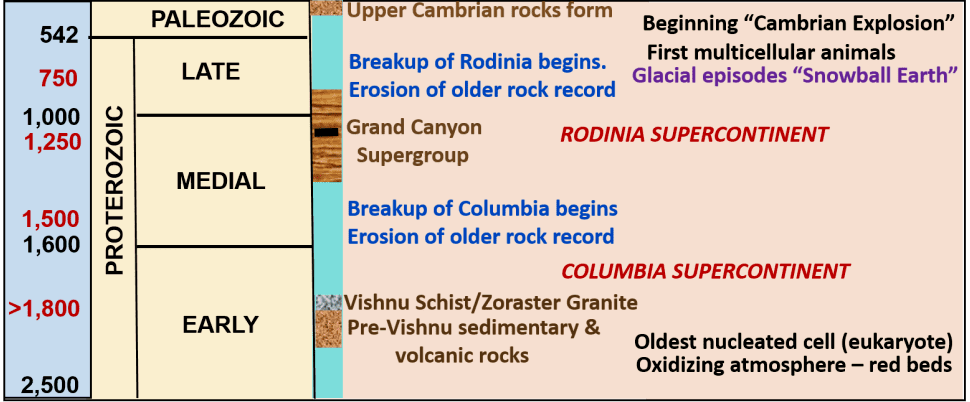
In a previous article on the Grand Canyon, we noted that the Early Proterozoic Columbia Supercontinent began to break apart about 1,500 million years ago. This resulted in the erosion of previously existing mountains and rocks of that continent. Erosion continued for almost 300 million years until about 1,250 million years ago and resulted in Vishnu Complex rocks being exposed at a land surface that was beveled nearly flat and had no vegetation. A modern example of what this erosion surface may have looked like is provided by exposed crystalline core rocks of Proterozoic age mountains on the Canadian Shield. This erosion surface is the result of glacial erosion during the last few million years of the ice ages (Figure 2).
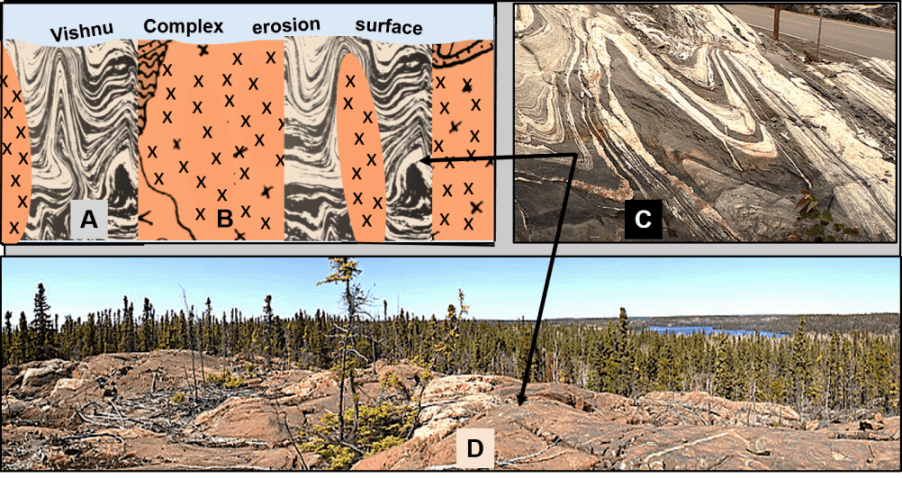
Lying unconformably above crystalline igneous and metamorphic rocks of the Vishnu Complex is a succession of sedimentary and volcanic rocks that collectively are named the Grand Canyon Supergroup. and collectively they represent about 500 million years of geologic time. These rocks were originally named by Charles Walcott in 1893-1984 (see Figure 2 in Grand Canyon Part 1). The contact between these two groups of rocks is termed a nonconformity (Figure 3).
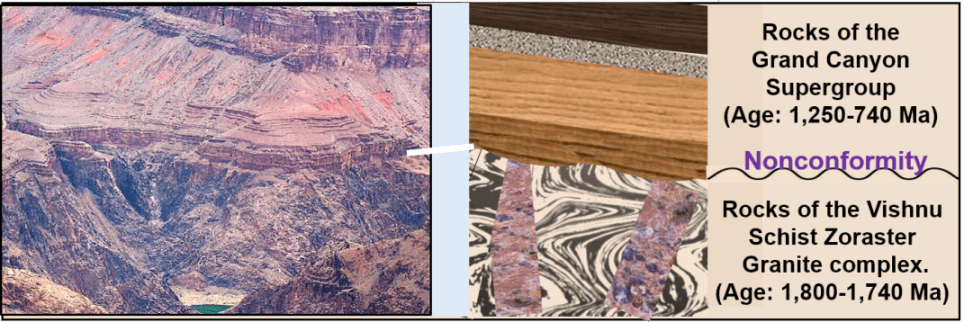
Oldest rocks of the Grand Canyon Supergroup formed about 1,250 million years ago, and therefore are 500 million years younger than the underlying Vishnu rocks (1,740+ Ma). There are no rocks present at the Grand Canyon representing this very long interval of geologic time. However, farther west in southern Nevada and southeastern California around the Death Valley region a thick succession of sedimentary rocks representing this interval of time is preserved and provides a record of ancient conditions during that interval of time.
Rock formations of the Grand Canyon Supergroup consist of a variety of lithologic types. Cumulatively this Supergroup is about 12,000 feet thick and represents another 500-million-year interval of time. These rocks were deposited in a variety of ancient environments such as terrestrial lowlands with rivers and lakes, deltas, and a variety of shallow-water marine environments (Figure 4). These rocks were being deposited as another supercontinent, Rodinia was forming beginning about 1,250 million years ago. As Rodinia began to break up about 750 million years ago, these rocks underwent deformation (faulting and folding), and in many areas were eroded away.
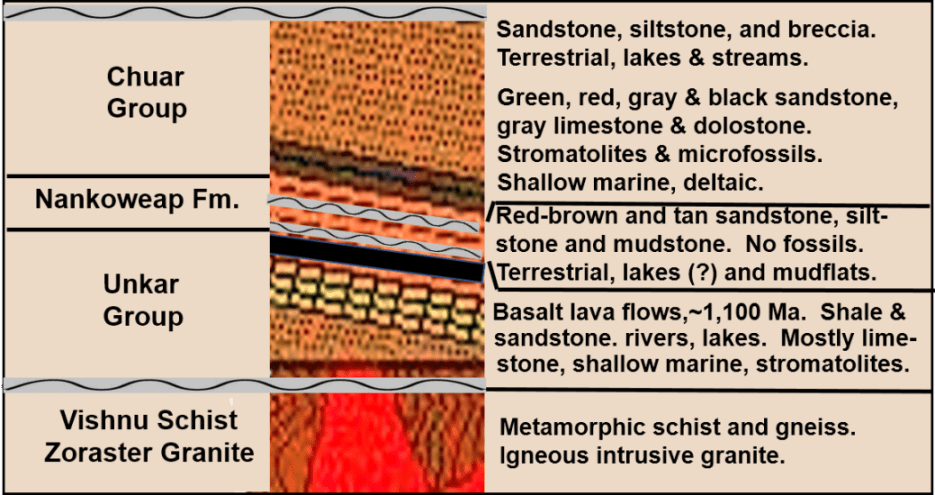
Unkar Group
Unkar Group rocks include five formations: Bass Formation, Hakatai Shale, Shinumo Quartzite, Dox Formation, and Cardenas Basalt (Figure 5). These rocks formed between 1,250 Ma (radiometrically dated volcanic ash layer in Bass Formation) and 1104 Ma (radiometrically dated Cardenas Basalt). Total thickness ranges from 5,200-7,200 feet. Formations in the Unkar Group formed mostly in shallow water marine environments and terrestrial river systems and deltas.
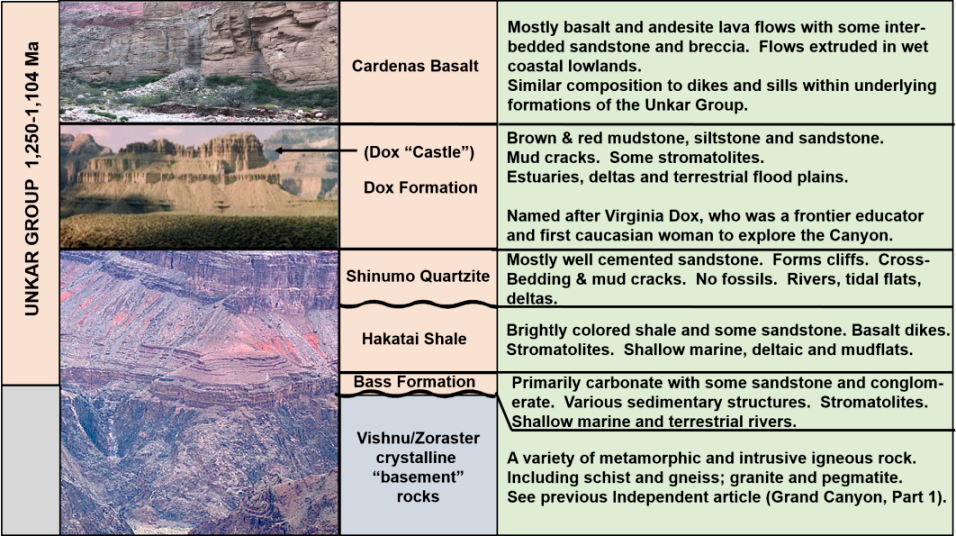
An interval of volcanic basalt and andesite flows in the upper part of the Unkar Group are named the Cardenas Basalt. These igneous rocks have been radiometrically dated (Potassium-Argon method) indicating the eruptions occurred about 1,100 million years ago. This volcanism represents evidence of the final formation of Rodinia at about 1,100 million years ago (Figure 6). The formation of Rodinia generated a mountain range in this region. When this continent began to break apart about 740 million years ago one result was tilting and faulting of the Supergroup rocks.
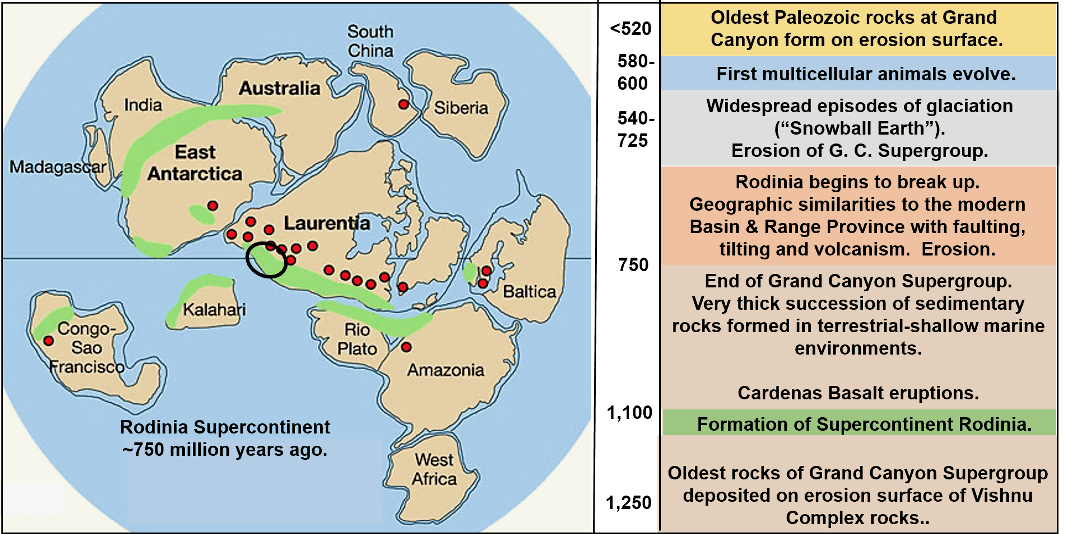
Fossils are rare in Unkar rocks and consist mostly of various types of single-celled organisms such as bacteria and possibly algae. Some of the rocks also contain stromatolites which are layered dome-shaped structures formed from fine-grained sedimentary particles trapped by successive generations of blue-green bacteria (cyanobacteria). No multicellular animal or plant fossils have been found in these rocks and that is consistent with similar age rocks globally. These organisms simply had not yet appeared on Earth.
Nankoweap Formation
The Nankoweap Formation unconformably overlies the Cardenas Basalt and its most distinctive red beds of sandstone, siltstone, and mudstone with a total thickness of about 300 feet. Geologic age is approximately 770 million years old, thus these rocks are a little over 300 million years younger than the underlying Cardenas Basalt (Figure 7). Depositional environments are poorly known but appear to have been sand or mudflats and shallow marine or lakes.
Because of their similar age and composition, some geologists consider the formation to be part of the overlying Chuar Group.
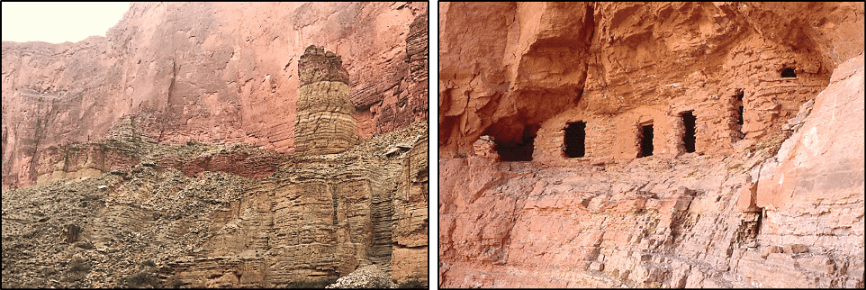
Chuar Group
This group of rocks is represented by two formations, a lower Galeros Formation, and an upper Kwagunt Formation. Combined thickness is approximately 5,200 feet and consists mostly of fine-grained mudstone, siltstone, and some limestone. The Galeras Formation is a variable colored limestone with sandstone, siltstone, and mudstone. Structures such as ripple marks and mud cracks occur in the fine-grained sediments and fossil stromatolites occur in limestone. These rocks were deposited in shallow marine water, intertidal flats, deltas, and terrestrial rivers.
Fossilized stromatolites and microscopic “vase-shaped microfossils” are present; these microfossils have been considered either bacteria or possibly algae (Figure 8).
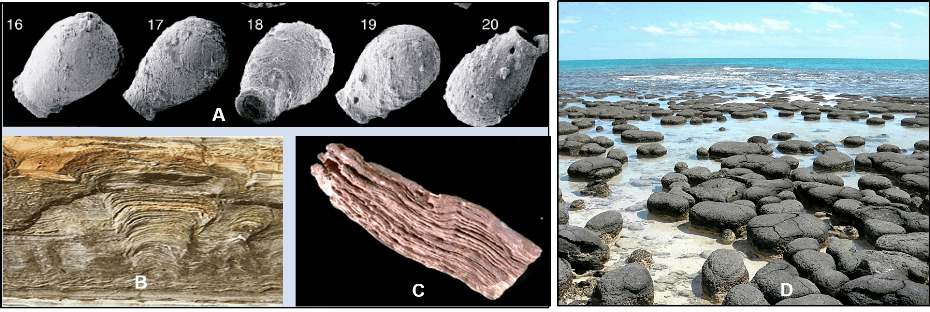
The Kwagunt Formation is red to brown limestone, black shale, and red to purple mudstone. Fossil stromatolites occur in limestone. These rocks were also deposited in shallow marine water, intertidal flats, and deltas.
Breakup of Rodinia
When Rodinia began to break apart about 740 million years ago, the processes of weathering and erosion again began their slow but relentless work. Today, rocks of the Supergroup are found mostly in the eastern and northern portions of the Grand Canyon and are usually found only as incomplete sections with tilted and faulted rocks.
In the Grand Canyon region rocks representing the time interval from about 740 to about 510 million years ago are not present. And again, thick sections of rocks of this time interval are preserved to the west, especially in desert regions of southern Nevada and southeastern California.
Chemical isotopic features and distinctive rocks from other parts of the world suggest that a lowering of worldwide sea level due to the formation of widespread glaciers occurred around 700 million years ago, and this may have accelerated the rate of erosion. This glacial event has been termed “Snowball Earth,” although other glacial episodes occurred periodically over the next 200 million years.
A Major Evolutionary Milestone
A provocative hypothesis proposed for the time interval from 700-540 million years ago is based on the following evidence: (1) The rock record suggests that the percentage of oxygen gas in the atmosphere and oceans was increasing, but still was significantly below that of today. (2) Changes in the chemistry of ocean water resulted from the formation of widespread glaciers during Snowball Earth followed by their subsequent melting. (3) Chemical isotopic studies of remaining rocks from this interval indicate that average global atmospheric temperature during non-glacial episodes was at least a few degrees warmer than at the present time.
These three global conditions may have acted as a trigger for the evolution of multicellular animals, which first appear in rocks about 580 million years old. They had no hard parts, so the fact that some are preserved is quite fortuitous. They are preserved as impressions on the surface of rocks, mainly sandstones, and siltstones (Figure 9). So, it appears that multicellular animals had finally made their appearance on Earth…after about 85 percent of the 4.5 billion years of the planet’s existence had passed! Unfortunately, no rocks of this interval of geologic time are preserved in the Grand Canyon region.
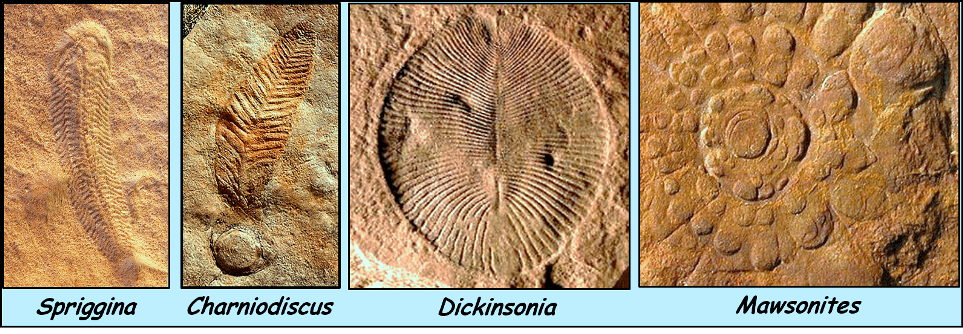
All of these preserved animals were small, not more than a few inches in length and very thin. They had no obvious internal organs or organ systems, no internal or external hard parts, and appear to have had a “quilted” surface texture. We’ve come a long way since that time!
This first appearance of these relatively simple animals was followed by animals with mineralized hard parts, such as protective shells, about 540 million years ago. That mineralization seems to have been a trigger for the subsequent evolutionary success of animals, literally an explosion of life that began in overlying Cambrian time and is recorded by a wide variety of fossils. Unfortunately, there are no rocks of this time interval preserved at the Grand Canyon.
Final Comment
At this point, we have traveled through approximately 1.2 billion years of geologic history at the Grand Canyon, although as noted much of that time is not recorded in the rock record of the Canyon. In the next article, we will make our escape from the confines of the Inner Gorge and discover that the upper surfaces of the Grand Canyon Supergroup rocks and Vishnu Complex in a different part of the Canyon represent an erosion surface, with the younger Paleozoic sedimentary rocks stacked above this surface.
Read Part One of this series here.



